Marine Spatial Planning Report: Irish Policy and SES/EGS Analysis
VerifiedAdded on 2022/07/28
|8
|2404
|22
Report
AI Summary
This report provides a comprehensive overview of Marine Spatial Planning (MSP) in the context of Ireland. It begins with an introduction to MSP, discussing the increasing competition for marine waters and the need for coordinated management to address conflicts and environmental pressures. The report then delves into the development of Irish MSP policy, including the Conceptual Framework for the Maritime Spatial Planning in the Mediterranean, the National Marine Planning Framework (Irish draft), Project Ireland 2040, and Harnessing Our Ocean Wealth. A critical comparison is made of the incorporation of Socio-Ecological Systems (SES) and Environmental Goods and Services (EGS) in the MSP policy document. The report emphasizes the importance of integrating ecological principles into decision-making to ensure sustainability and protect marine ecosystems. The report also highlights the role of the MSP directive in Ireland and its integration of marine information to foster growth and innovation, particularly in the context of the 'blue economy'. Overall, the report provides an in-depth analysis of MSP and its role in managing Ireland's marine resources.
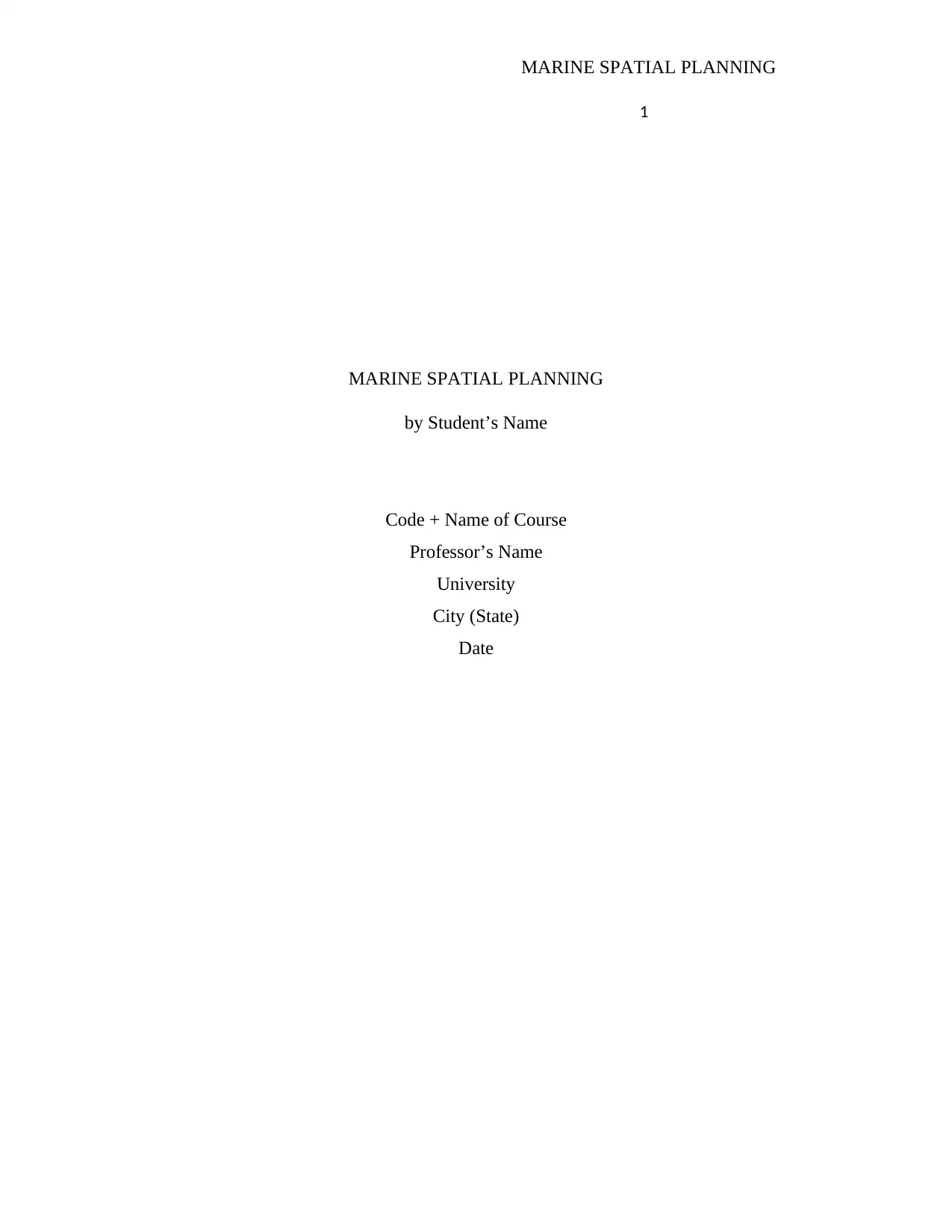
MARINE SPATIAL PLANNING
1
MARINE SPATIAL PLANNING
by Student’s Name
Code + Name of Course
Professor’s Name
University
City (State)
Date
1
MARINE SPATIAL PLANNING
by Student’s Name
Code + Name of Course
Professor’s Name
University
City (State)
Date
Paraphrase This Document
Need a fresh take? Get an instant paraphrase of this document with our AI Paraphraser
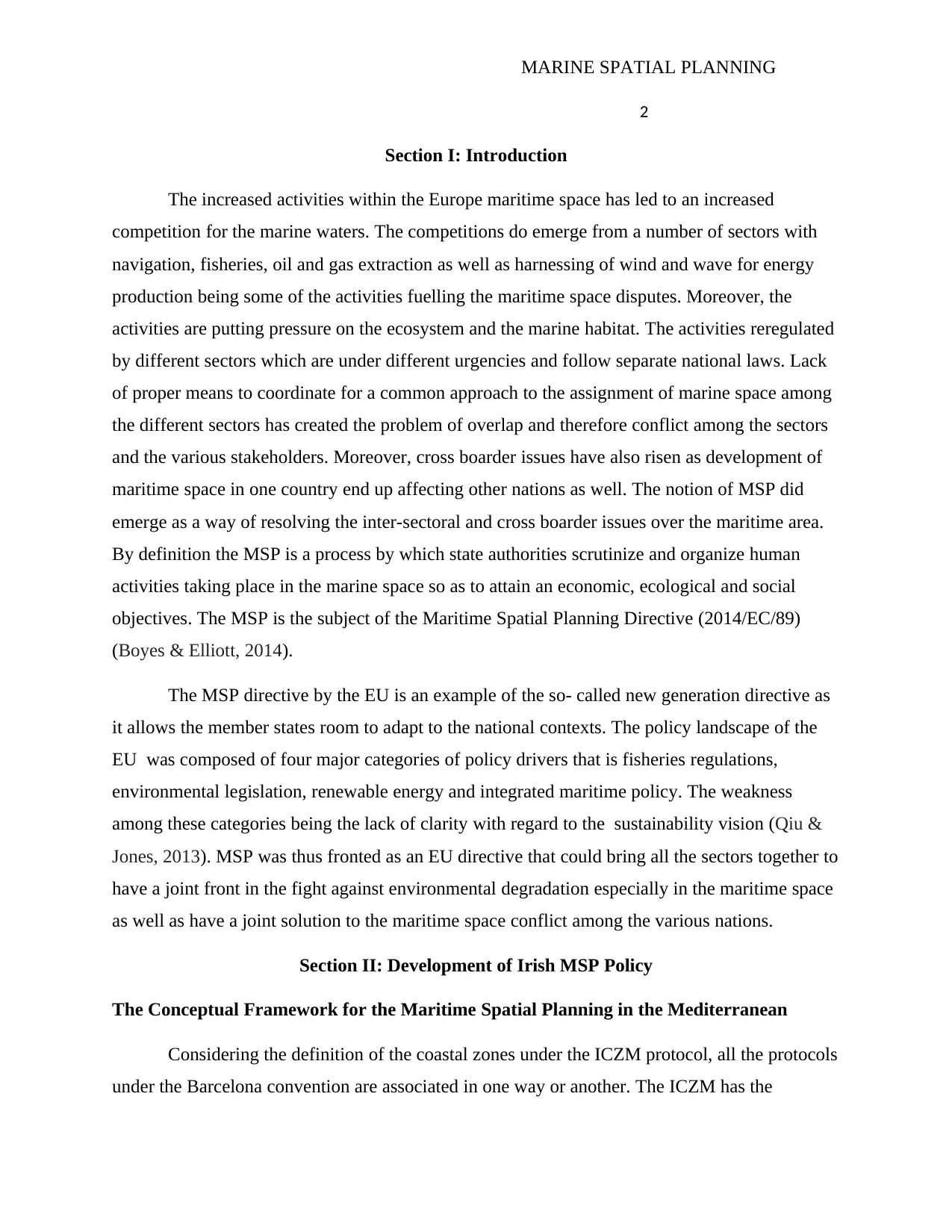
MARINE SPATIAL PLANNING
2
Section I: Introduction
The increased activities within the Europe maritime space has led to an increased
competition for the marine waters. The competitions do emerge from a number of sectors with
navigation, fisheries, oil and gas extraction as well as harnessing of wind and wave for energy
production being some of the activities fuelling the maritime space disputes. Moreover, the
activities are putting pressure on the ecosystem and the marine habitat. The activities reregulated
by different sectors which are under different urgencies and follow separate national laws. Lack
of proper means to coordinate for a common approach to the assignment of marine space among
the different sectors has created the problem of overlap and therefore conflict among the sectors
and the various stakeholders. Moreover, cross boarder issues have also risen as development of
maritime space in one country end up affecting other nations as well. The notion of MSP did
emerge as a way of resolving the inter-sectoral and cross boarder issues over the maritime area.
By definition the MSP is a process by which state authorities scrutinize and organize human
activities taking place in the marine space so as to attain an economic, ecological and social
objectives. The MSP is the subject of the Maritime Spatial Planning Directive (2014/EC/89)
(Boyes & Elliott, 2014).
The MSP directive by the EU is an example of the so- called new generation directive as
it allows the member states room to adapt to the national contexts. The policy landscape of the
EU was composed of four major categories of policy drivers that is fisheries regulations,
environmental legislation, renewable energy and integrated maritime policy. The weakness
among these categories being the lack of clarity with regard to the sustainability vision (Qiu &
Jones, 2013). MSP was thus fronted as an EU directive that could bring all the sectors together to
have a joint front in the fight against environmental degradation especially in the maritime space
as well as have a joint solution to the maritime space conflict among the various nations.
Section II: Development of Irish MSP Policy
The Conceptual Framework for the Maritime Spatial Planning in the Mediterranean
Considering the definition of the coastal zones under the ICZM protocol, all the protocols
under the Barcelona convention are associated in one way or another. The ICZM has the
2
Section I: Introduction
The increased activities within the Europe maritime space has led to an increased
competition for the marine waters. The competitions do emerge from a number of sectors with
navigation, fisheries, oil and gas extraction as well as harnessing of wind and wave for energy
production being some of the activities fuelling the maritime space disputes. Moreover, the
activities are putting pressure on the ecosystem and the marine habitat. The activities reregulated
by different sectors which are under different urgencies and follow separate national laws. Lack
of proper means to coordinate for a common approach to the assignment of marine space among
the different sectors has created the problem of overlap and therefore conflict among the sectors
and the various stakeholders. Moreover, cross boarder issues have also risen as development of
maritime space in one country end up affecting other nations as well. The notion of MSP did
emerge as a way of resolving the inter-sectoral and cross boarder issues over the maritime area.
By definition the MSP is a process by which state authorities scrutinize and organize human
activities taking place in the marine space so as to attain an economic, ecological and social
objectives. The MSP is the subject of the Maritime Spatial Planning Directive (2014/EC/89)
(Boyes & Elliott, 2014).
The MSP directive by the EU is an example of the so- called new generation directive as
it allows the member states room to adapt to the national contexts. The policy landscape of the
EU was composed of four major categories of policy drivers that is fisheries regulations,
environmental legislation, renewable energy and integrated maritime policy. The weakness
among these categories being the lack of clarity with regard to the sustainability vision (Qiu &
Jones, 2013). MSP was thus fronted as an EU directive that could bring all the sectors together to
have a joint front in the fight against environmental degradation especially in the maritime space
as well as have a joint solution to the maritime space conflict among the various nations.
Section II: Development of Irish MSP Policy
The Conceptual Framework for the Maritime Spatial Planning in the Mediterranean
Considering the definition of the coastal zones under the ICZM protocol, all the protocols
under the Barcelona convention are associated in one way or another. The ICZM has the
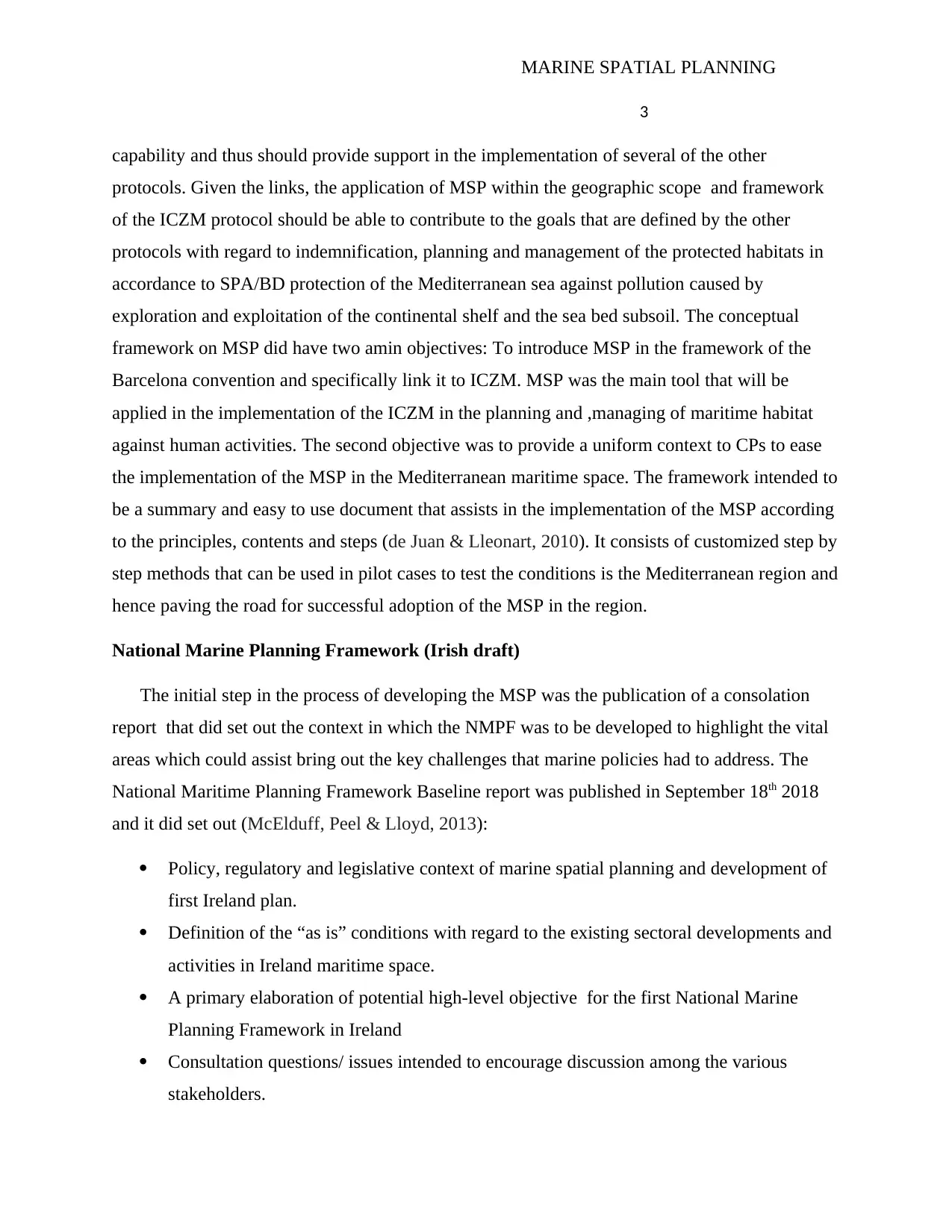
MARINE SPATIAL PLANNING
3
capability and thus should provide support in the implementation of several of the other
protocols. Given the links, the application of MSP within the geographic scope and framework
of the ICZM protocol should be able to contribute to the goals that are defined by the other
protocols with regard to indemnification, planning and management of the protected habitats in
accordance to SPA/BD protection of the Mediterranean sea against pollution caused by
exploration and exploitation of the continental shelf and the sea bed subsoil. The conceptual
framework on MSP did have two amin objectives: To introduce MSP in the framework of the
Barcelona convention and specifically link it to ICZM. MSP was the main tool that will be
applied in the implementation of the ICZM in the planning and ,managing of maritime habitat
against human activities. The second objective was to provide a uniform context to CPs to ease
the implementation of the MSP in the Mediterranean maritime space. The framework intended to
be a summary and easy to use document that assists in the implementation of the MSP according
to the principles, contents and steps (de Juan & Lleonart, 2010). It consists of customized step by
step methods that can be used in pilot cases to test the conditions is the Mediterranean region and
hence paving the road for successful adoption of the MSP in the region.
National Marine Planning Framework (Irish draft)
The initial step in the process of developing the MSP was the publication of a consolation
report that did set out the context in which the NMPF was to be developed to highlight the vital
areas which could assist bring out the key challenges that marine policies had to address. The
National Maritime Planning Framework Baseline report was published in September 18th 2018
and it did set out (McElduff, Peel & Lloyd, 2013):
Policy, regulatory and legislative context of marine spatial planning and development of
first Ireland plan.
Definition of the “as is” conditions with regard to the existing sectoral developments and
activities in Ireland maritime space.
A primary elaboration of potential high-level objective for the first National Marine
Planning Framework in Ireland
Consultation questions/ issues intended to encourage discussion among the various
stakeholders.
3
capability and thus should provide support in the implementation of several of the other
protocols. Given the links, the application of MSP within the geographic scope and framework
of the ICZM protocol should be able to contribute to the goals that are defined by the other
protocols with regard to indemnification, planning and management of the protected habitats in
accordance to SPA/BD protection of the Mediterranean sea against pollution caused by
exploration and exploitation of the continental shelf and the sea bed subsoil. The conceptual
framework on MSP did have two amin objectives: To introduce MSP in the framework of the
Barcelona convention and specifically link it to ICZM. MSP was the main tool that will be
applied in the implementation of the ICZM in the planning and ,managing of maritime habitat
against human activities. The second objective was to provide a uniform context to CPs to ease
the implementation of the MSP in the Mediterranean maritime space. The framework intended to
be a summary and easy to use document that assists in the implementation of the MSP according
to the principles, contents and steps (de Juan & Lleonart, 2010). It consists of customized step by
step methods that can be used in pilot cases to test the conditions is the Mediterranean region and
hence paving the road for successful adoption of the MSP in the region.
National Marine Planning Framework (Irish draft)
The initial step in the process of developing the MSP was the publication of a consolation
report that did set out the context in which the NMPF was to be developed to highlight the vital
areas which could assist bring out the key challenges that marine policies had to address. The
National Maritime Planning Framework Baseline report was published in September 18th 2018
and it did set out (McElduff, Peel & Lloyd, 2013):
Policy, regulatory and legislative context of marine spatial planning and development of
first Ireland plan.
Definition of the “as is” conditions with regard to the existing sectoral developments and
activities in Ireland maritime space.
A primary elaboration of potential high-level objective for the first National Marine
Planning Framework in Ireland
Consultation questions/ issues intended to encourage discussion among the various
stakeholders.
⊘ This is a preview!⊘
Do you want full access?
Subscribe today to unlock all pages.

Trusted by 1+ million students worldwide
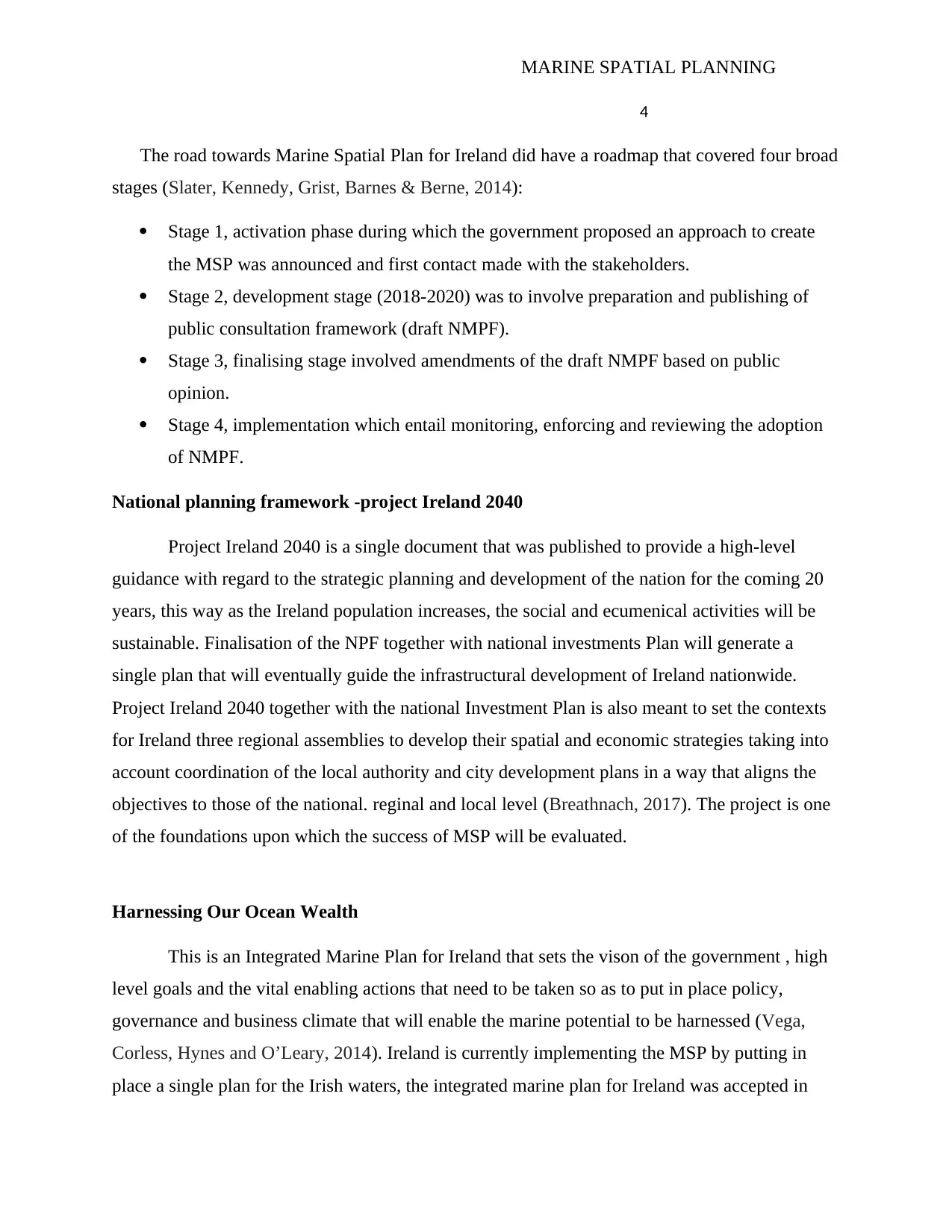
MARINE SPATIAL PLANNING
4
The road towards Marine Spatial Plan for Ireland did have a roadmap that covered four broad
stages (Slater, Kennedy, Grist, Barnes & Berne, 2014):
Stage 1, activation phase during which the government proposed an approach to create
the MSP was announced and first contact made with the stakeholders.
Stage 2, development stage (2018-2020) was to involve preparation and publishing of
public consultation framework (draft NMPF).
Stage 3, finalising stage involved amendments of the draft NMPF based on public
opinion.
Stage 4, implementation which entail monitoring, enforcing and reviewing the adoption
of NMPF.
National planning framework -project Ireland 2040
Project Ireland 2040 is a single document that was published to provide a high-level
guidance with regard to the strategic planning and development of the nation for the coming 20
years, this way as the Ireland population increases, the social and ecumenical activities will be
sustainable. Finalisation of the NPF together with national investments Plan will generate a
single plan that will eventually guide the infrastructural development of Ireland nationwide.
Project Ireland 2040 together with the national Investment Plan is also meant to set the contexts
for Ireland three regional assemblies to develop their spatial and economic strategies taking into
account coordination of the local authority and city development plans in a way that aligns the
objectives to those of the national. reginal and local level (Breathnach, 2017). The project is one
of the foundations upon which the success of MSP will be evaluated.
Harnessing Our Ocean Wealth
This is an Integrated Marine Plan for Ireland that sets the vison of the government , high
level goals and the vital enabling actions that need to be taken so as to put in place policy,
governance and business climate that will enable the marine potential to be harnessed (Vega,
Corless, Hynes and O’Leary, 2014). Ireland is currently implementing the MSP by putting in
place a single plan for the Irish waters, the integrated marine plan for Ireland was accepted in
4
The road towards Marine Spatial Plan for Ireland did have a roadmap that covered four broad
stages (Slater, Kennedy, Grist, Barnes & Berne, 2014):
Stage 1, activation phase during which the government proposed an approach to create
the MSP was announced and first contact made with the stakeholders.
Stage 2, development stage (2018-2020) was to involve preparation and publishing of
public consultation framework (draft NMPF).
Stage 3, finalising stage involved amendments of the draft NMPF based on public
opinion.
Stage 4, implementation which entail monitoring, enforcing and reviewing the adoption
of NMPF.
National planning framework -project Ireland 2040
Project Ireland 2040 is a single document that was published to provide a high-level
guidance with regard to the strategic planning and development of the nation for the coming 20
years, this way as the Ireland population increases, the social and ecumenical activities will be
sustainable. Finalisation of the NPF together with national investments Plan will generate a
single plan that will eventually guide the infrastructural development of Ireland nationwide.
Project Ireland 2040 together with the national Investment Plan is also meant to set the contexts
for Ireland three regional assemblies to develop their spatial and economic strategies taking into
account coordination of the local authority and city development plans in a way that aligns the
objectives to those of the national. reginal and local level (Breathnach, 2017). The project is one
of the foundations upon which the success of MSP will be evaluated.
Harnessing Our Ocean Wealth
This is an Integrated Marine Plan for Ireland that sets the vison of the government , high
level goals and the vital enabling actions that need to be taken so as to put in place policy,
governance and business climate that will enable the marine potential to be harnessed (Vega,
Corless, Hynes and O’Leary, 2014). Ireland is currently implementing the MSP by putting in
place a single plan for the Irish waters, the integrated marine plan for Ireland was accepted in
Paraphrase This Document
Need a fresh take? Get an instant paraphrase of this document with our AI Paraphraser
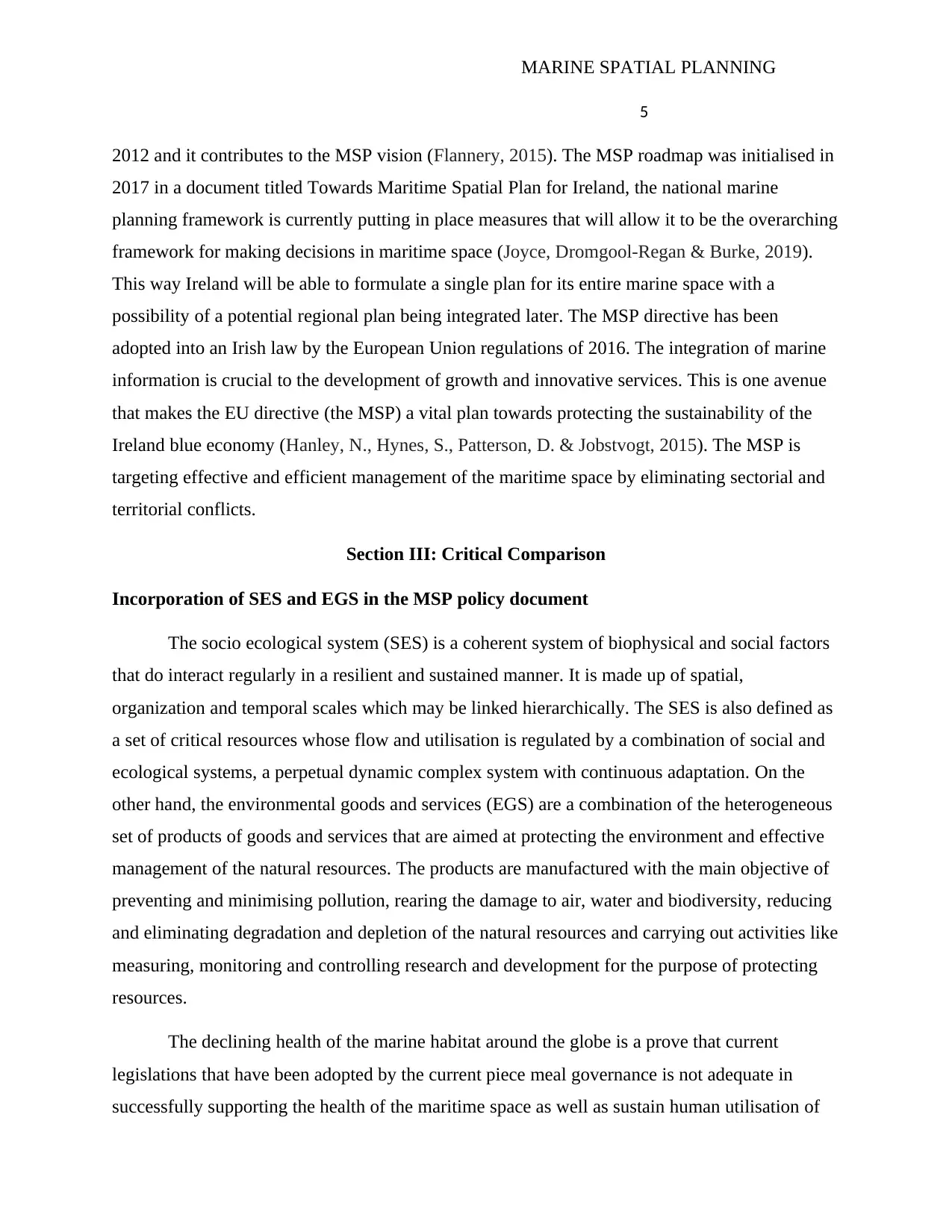
MARINE SPATIAL PLANNING
5
2012 and it contributes to the MSP vision (Flannery, 2015). The MSP roadmap was initialised in
2017 in a document titled Towards Maritime Spatial Plan for Ireland, the national marine
planning framework is currently putting in place measures that will allow it to be the overarching
framework for making decisions in maritime space (Joyce, Dromgool-Regan & Burke, 2019).
This way Ireland will be able to formulate a single plan for its entire marine space with a
possibility of a potential regional plan being integrated later. The MSP directive has been
adopted into an Irish law by the European Union regulations of 2016. The integration of marine
information is crucial to the development of growth and innovative services. This is one avenue
that makes the EU directive (the MSP) a vital plan towards protecting the sustainability of the
Ireland blue economy (Hanley, N., Hynes, S., Patterson, D. & Jobstvogt, 2015). The MSP is
targeting effective and efficient management of the maritime space by eliminating sectorial and
territorial conflicts.
Section III: Critical Comparison
Incorporation of SES and EGS in the MSP policy document
The socio ecological system (SES) is a coherent system of biophysical and social factors
that do interact regularly in a resilient and sustained manner. It is made up of spatial,
organization and temporal scales which may be linked hierarchically. The SES is also defined as
a set of critical resources whose flow and utilisation is regulated by a combination of social and
ecological systems, a perpetual dynamic complex system with continuous adaptation. On the
other hand, the environmental goods and services (EGS) are a combination of the heterogeneous
set of products of goods and services that are aimed at protecting the environment and effective
management of the natural resources. The products are manufactured with the main objective of
preventing and minimising pollution, rearing the damage to air, water and biodiversity, reducing
and eliminating degradation and depletion of the natural resources and carrying out activities like
measuring, monitoring and controlling research and development for the purpose of protecting
resources.
The declining health of the marine habitat around the globe is a prove that current
legislations that have been adopted by the current piece meal governance is not adequate in
successfully supporting the health of the maritime space as well as sustain human utilisation of
5
2012 and it contributes to the MSP vision (Flannery, 2015). The MSP roadmap was initialised in
2017 in a document titled Towards Maritime Spatial Plan for Ireland, the national marine
planning framework is currently putting in place measures that will allow it to be the overarching
framework for making decisions in maritime space (Joyce, Dromgool-Regan & Burke, 2019).
This way Ireland will be able to formulate a single plan for its entire marine space with a
possibility of a potential regional plan being integrated later. The MSP directive has been
adopted into an Irish law by the European Union regulations of 2016. The integration of marine
information is crucial to the development of growth and innovative services. This is one avenue
that makes the EU directive (the MSP) a vital plan towards protecting the sustainability of the
Ireland blue economy (Hanley, N., Hynes, S., Patterson, D. & Jobstvogt, 2015). The MSP is
targeting effective and efficient management of the maritime space by eliminating sectorial and
territorial conflicts.
Section III: Critical Comparison
Incorporation of SES and EGS in the MSP policy document
The socio ecological system (SES) is a coherent system of biophysical and social factors
that do interact regularly in a resilient and sustained manner. It is made up of spatial,
organization and temporal scales which may be linked hierarchically. The SES is also defined as
a set of critical resources whose flow and utilisation is regulated by a combination of social and
ecological systems, a perpetual dynamic complex system with continuous adaptation. On the
other hand, the environmental goods and services (EGS) are a combination of the heterogeneous
set of products of goods and services that are aimed at protecting the environment and effective
management of the natural resources. The products are manufactured with the main objective of
preventing and minimising pollution, rearing the damage to air, water and biodiversity, reducing
and eliminating degradation and depletion of the natural resources and carrying out activities like
measuring, monitoring and controlling research and development for the purpose of protecting
resources.
The declining health of the marine habitat around the globe is a prove that current
legislations that have been adopted by the current piece meal governance is not adequate in
successfully supporting the health of the maritime space as well as sustain human utilisation of
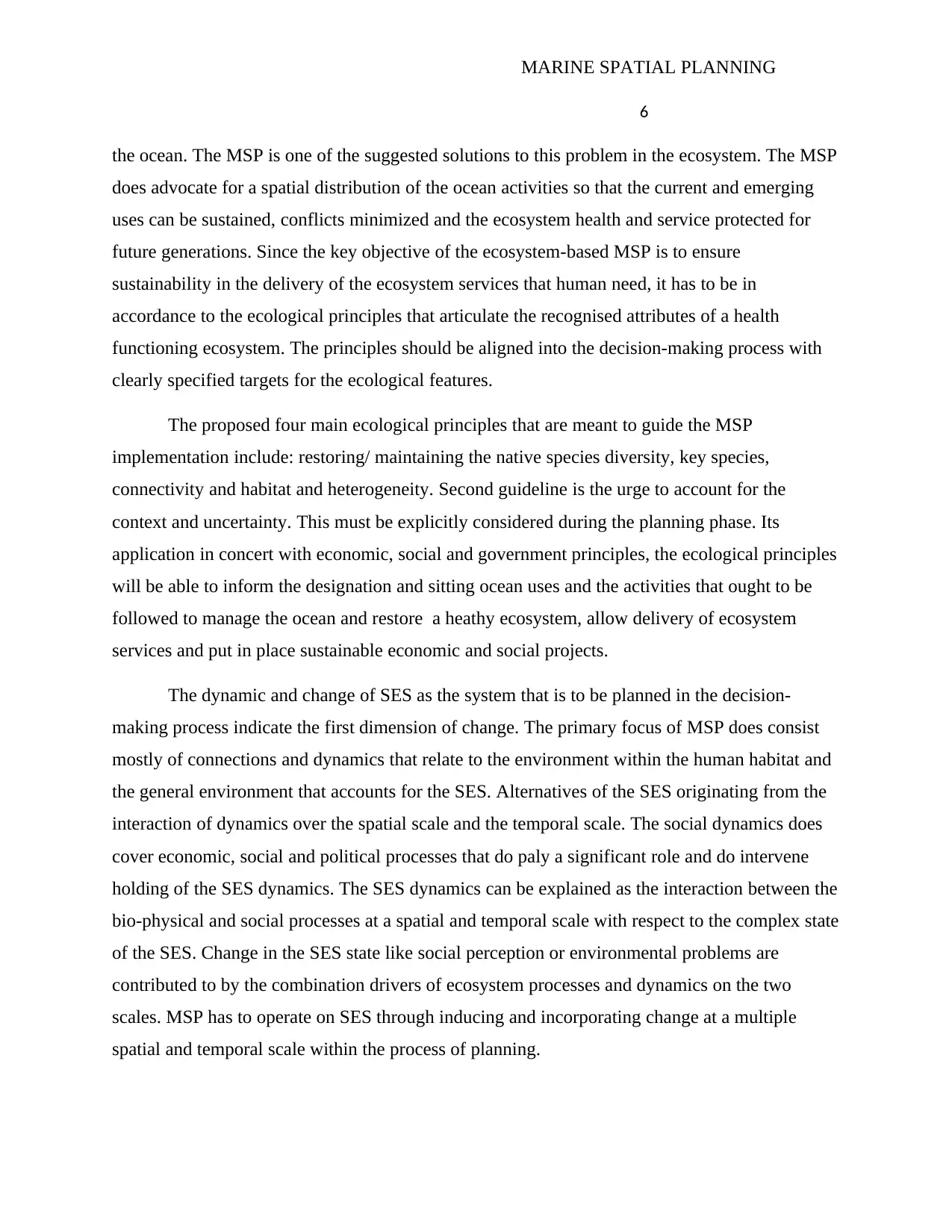
MARINE SPATIAL PLANNING
6
the ocean. The MSP is one of the suggested solutions to this problem in the ecosystem. The MSP
does advocate for a spatial distribution of the ocean activities so that the current and emerging
uses can be sustained, conflicts minimized and the ecosystem health and service protected for
future generations. Since the key objective of the ecosystem-based MSP is to ensure
sustainability in the delivery of the ecosystem services that human need, it has to be in
accordance to the ecological principles that articulate the recognised attributes of a health
functioning ecosystem. The principles should be aligned into the decision-making process with
clearly specified targets for the ecological features.
The proposed four main ecological principles that are meant to guide the MSP
implementation include: restoring/ maintaining the native species diversity, key species,
connectivity and habitat and heterogeneity. Second guideline is the urge to account for the
context and uncertainty. This must be explicitly considered during the planning phase. Its
application in concert with economic, social and government principles, the ecological principles
will be able to inform the designation and sitting ocean uses and the activities that ought to be
followed to manage the ocean and restore a heathy ecosystem, allow delivery of ecosystem
services and put in place sustainable economic and social projects.
The dynamic and change of SES as the system that is to be planned in the decision-
making process indicate the first dimension of change. The primary focus of MSP does consist
mostly of connections and dynamics that relate to the environment within the human habitat and
the general environment that accounts for the SES. Alternatives of the SES originating from the
interaction of dynamics over the spatial scale and the temporal scale. The social dynamics does
cover economic, social and political processes that do paly a significant role and do intervene
holding of the SES dynamics. The SES dynamics can be explained as the interaction between the
bio-physical and social processes at a spatial and temporal scale with respect to the complex state
of the SES. Change in the SES state like social perception or environmental problems are
contributed to by the combination drivers of ecosystem processes and dynamics on the two
scales. MSP has to operate on SES through inducing and incorporating change at a multiple
spatial and temporal scale within the process of planning.
6
the ocean. The MSP is one of the suggested solutions to this problem in the ecosystem. The MSP
does advocate for a spatial distribution of the ocean activities so that the current and emerging
uses can be sustained, conflicts minimized and the ecosystem health and service protected for
future generations. Since the key objective of the ecosystem-based MSP is to ensure
sustainability in the delivery of the ecosystem services that human need, it has to be in
accordance to the ecological principles that articulate the recognised attributes of a health
functioning ecosystem. The principles should be aligned into the decision-making process with
clearly specified targets for the ecological features.
The proposed four main ecological principles that are meant to guide the MSP
implementation include: restoring/ maintaining the native species diversity, key species,
connectivity and habitat and heterogeneity. Second guideline is the urge to account for the
context and uncertainty. This must be explicitly considered during the planning phase. Its
application in concert with economic, social and government principles, the ecological principles
will be able to inform the designation and sitting ocean uses and the activities that ought to be
followed to manage the ocean and restore a heathy ecosystem, allow delivery of ecosystem
services and put in place sustainable economic and social projects.
The dynamic and change of SES as the system that is to be planned in the decision-
making process indicate the first dimension of change. The primary focus of MSP does consist
mostly of connections and dynamics that relate to the environment within the human habitat and
the general environment that accounts for the SES. Alternatives of the SES originating from the
interaction of dynamics over the spatial scale and the temporal scale. The social dynamics does
cover economic, social and political processes that do paly a significant role and do intervene
holding of the SES dynamics. The SES dynamics can be explained as the interaction between the
bio-physical and social processes at a spatial and temporal scale with respect to the complex state
of the SES. Change in the SES state like social perception or environmental problems are
contributed to by the combination drivers of ecosystem processes and dynamics on the two
scales. MSP has to operate on SES through inducing and incorporating change at a multiple
spatial and temporal scale within the process of planning.
⊘ This is a preview!⊘
Do you want full access?
Subscribe today to unlock all pages.

Trusted by 1+ million students worldwide
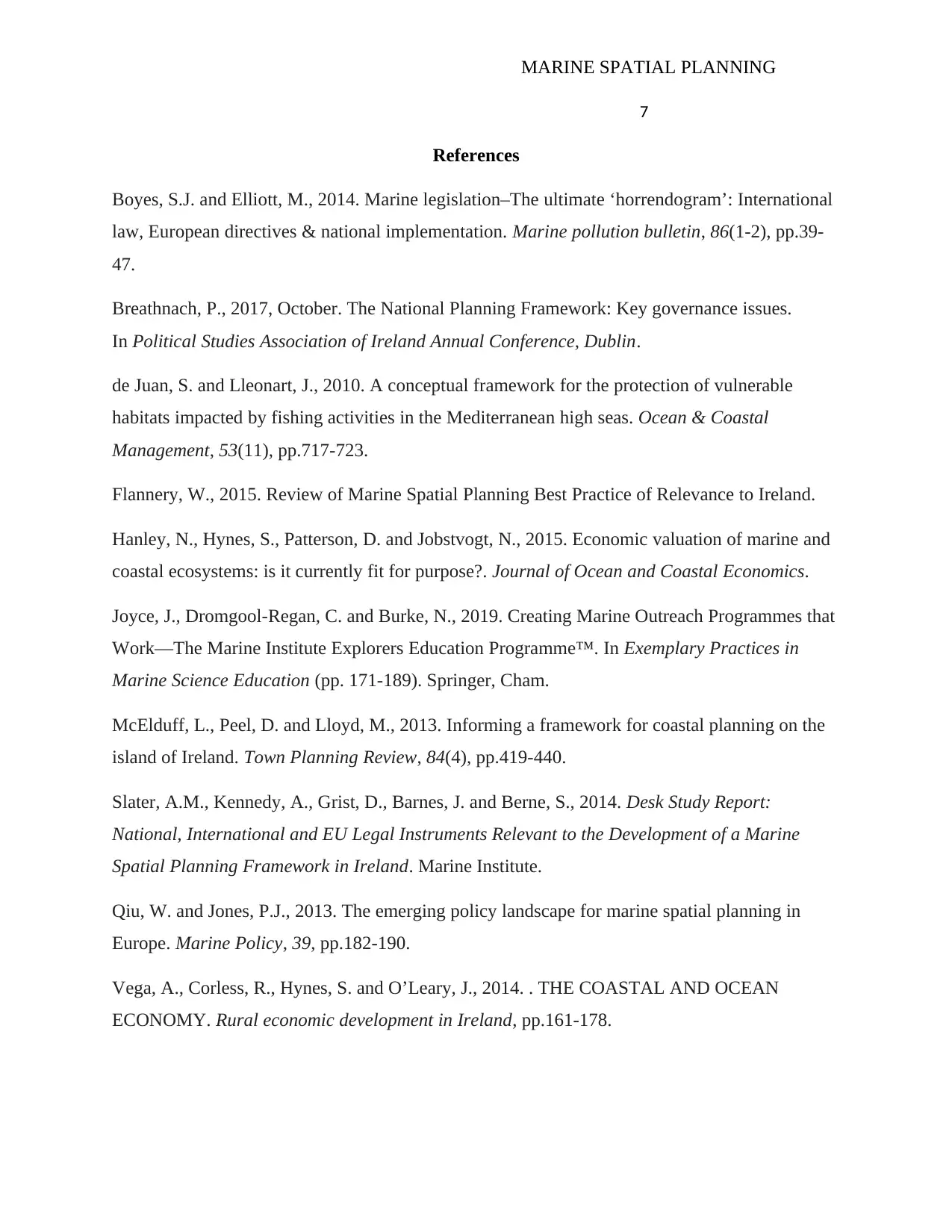
MARINE SPATIAL PLANNING
7
References
Boyes, S.J. and Elliott, M., 2014. Marine legislation–The ultimate ‘horrendogram’: International
law, European directives & national implementation. Marine pollution bulletin, 86(1-2), pp.39-
47.
Breathnach, P., 2017, October. The National Planning Framework: Key governance issues.
In Political Studies Association of Ireland Annual Conference, Dublin.
de Juan, S. and Lleonart, J., 2010. A conceptual framework for the protection of vulnerable
habitats impacted by fishing activities in the Mediterranean high seas. Ocean & Coastal
Management, 53(11), pp.717-723.
Flannery, W., 2015. Review of Marine Spatial Planning Best Practice of Relevance to Ireland.
Hanley, N., Hynes, S., Patterson, D. and Jobstvogt, N., 2015. Economic valuation of marine and
coastal ecosystems: is it currently fit for purpose?. Journal of Ocean and Coastal Economics.
Joyce, J., Dromgool-Regan, C. and Burke, N., 2019. Creating Marine Outreach Programmes that
Work—The Marine Institute Explorers Education Programme™. In Exemplary Practices in
Marine Science Education (pp. 171-189). Springer, Cham.
McElduff, L., Peel, D. and Lloyd, M., 2013. Informing a framework for coastal planning on the
island of Ireland. Town Planning Review, 84(4), pp.419-440.
Slater, A.M., Kennedy, A., Grist, D., Barnes, J. and Berne, S., 2014. Desk Study Report:
National, International and EU Legal Instruments Relevant to the Development of a Marine
Spatial Planning Framework in Ireland. Marine Institute.
Qiu, W. and Jones, P.J., 2013. The emerging policy landscape for marine spatial planning in
Europe. Marine Policy, 39, pp.182-190.
Vega, A., Corless, R., Hynes, S. and O’Leary, J., 2014. . THE COASTAL AND OCEAN
ECONOMY. Rural economic development in Ireland, pp.161-178.
7
References
Boyes, S.J. and Elliott, M., 2014. Marine legislation–The ultimate ‘horrendogram’: International
law, European directives & national implementation. Marine pollution bulletin, 86(1-2), pp.39-
47.
Breathnach, P., 2017, October. The National Planning Framework: Key governance issues.
In Political Studies Association of Ireland Annual Conference, Dublin.
de Juan, S. and Lleonart, J., 2010. A conceptual framework for the protection of vulnerable
habitats impacted by fishing activities in the Mediterranean high seas. Ocean & Coastal
Management, 53(11), pp.717-723.
Flannery, W., 2015. Review of Marine Spatial Planning Best Practice of Relevance to Ireland.
Hanley, N., Hynes, S., Patterson, D. and Jobstvogt, N., 2015. Economic valuation of marine and
coastal ecosystems: is it currently fit for purpose?. Journal of Ocean and Coastal Economics.
Joyce, J., Dromgool-Regan, C. and Burke, N., 2019. Creating Marine Outreach Programmes that
Work—The Marine Institute Explorers Education Programme™. In Exemplary Practices in
Marine Science Education (pp. 171-189). Springer, Cham.
McElduff, L., Peel, D. and Lloyd, M., 2013. Informing a framework for coastal planning on the
island of Ireland. Town Planning Review, 84(4), pp.419-440.
Slater, A.M., Kennedy, A., Grist, D., Barnes, J. and Berne, S., 2014. Desk Study Report:
National, International and EU Legal Instruments Relevant to the Development of a Marine
Spatial Planning Framework in Ireland. Marine Institute.
Qiu, W. and Jones, P.J., 2013. The emerging policy landscape for marine spatial planning in
Europe. Marine Policy, 39, pp.182-190.
Vega, A., Corless, R., Hynes, S. and O’Leary, J., 2014. . THE COASTAL AND OCEAN
ECONOMY. Rural economic development in Ireland, pp.161-178.
Paraphrase This Document
Need a fresh take? Get an instant paraphrase of this document with our AI Paraphraser

MARINE SPATIAL PLANNING
8
8
1 out of 8
Your All-in-One AI-Powered Toolkit for Academic Success.
+13062052269
info@desklib.com
Available 24*7 on WhatsApp / Email
![[object Object]](/_next/static/media/star-bottom.7253800d.svg)
Unlock your academic potential
Copyright © 2020–2025 A2Z Services. All Rights Reserved. Developed and managed by ZUCOL.